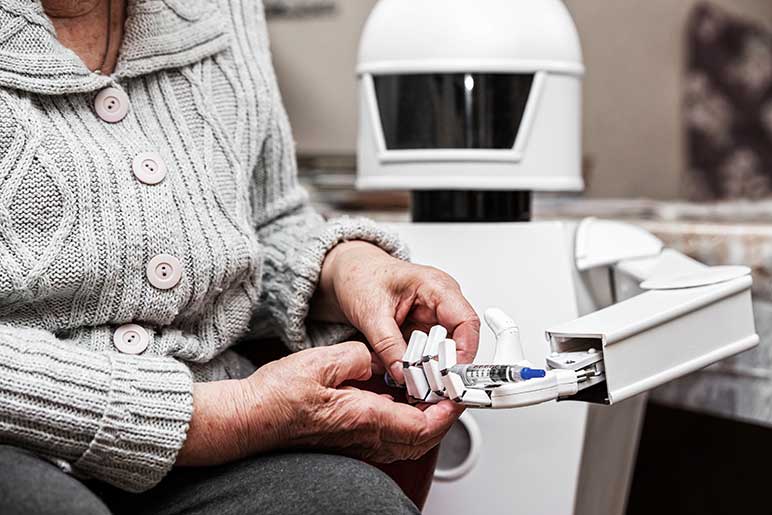The Man, the Myth, the Machine
By Nathan Worrell
Long-Term Care News, November 2023

Self-driving vehicles, industrial robots, flying drones and humanoid androids may seem like technological wonders of the modern age. Yet the inspirations for many of these inventions date back to times long in the past, way before people worried about where they lost their charger cables.
- Ancient Egyptians had stories of boats propelled by automaton rowers.
- Automatons appear in Greek mythology to aid in the construction of various items.
- Animatronic technology appears in ancient Chinese and Indian lore.
- Buddhist teachings include contemplations about the nature of wooden men and lovely mechanical dolls.
Fast-forward a few thousand years, and our relationship with machines continues to be a pervasive trope in science fiction literature and cinema. Some caution us that machines may kill or enslave us (Terminator, 2001: A Space Odyssey, The Matrix, Westworld). Others show us a softer side of the circuitry (I Am Robot, Her, A.I. Artificial Intelligence, Wall-E). And some have even dabbled in the realm of caretaking (Bicentennial Man, Frank and the Robot).
A couple of years ago, my entry in the Actuarial Speculative Fiction contest was inspired by these themes and took a robot into the world of long-term care. “Peanut Butter Cookies” features a mechanical nurse that assists with medicine administration, activities of daily living and baking—at least until the algorithm decides its patient is no longer maintainable.
Fiction and myth are becoming reality. Both computer-driven communication and robots are growing at a raucous pace.
- Boston Scientific has robots that can traverse a full obstacle course and finish with a backflip.
- Elon Musk has poured millions of research dollars into his brain-computer interface Neuralink.
- Drones and driverless vehicles are in the sky and on the road transporting goods and people.
- Who hasn’t chatted with GPT?
It turns out that the robot uprising may not be a calamitous catastrophe featuring machine guns and lasers. It is a quieter and slower process as automations and robotics move through various industries and integrate into our personal lives.
In this world of emerging technology, could elder care be the unexpected frontier of exploration for human-machine relationships? With aging populations across the globe, shortages of caretaking staff and high levels of burnout, the elder care industry seems primed for robots to take over. Japan has led the way with companion bots, lifting bots and other mechanical aids. Yet the path has not been smooth, with the robots occasionally creating more work than they save.
As more people take the roll of informal caregivers, an electronic assistant of some kind may be necessary. While households won’t look quite like the Jetsons’ anytime soon, other apps and avatars may become common dinner guests.
But what about Grandma? Not too long ago, Saturday Night Live put together an amusing sketch of seniors trying to talk to Amazon’s Alexa. However, the trope of elders being bumbling fools with new technology is quickly fading. The pandemic has had a lot to do with that, as virtual communication became an exclusive way of maintaining risk-free contact. In response, Tech players continue to tweak the design of their apps and interfaces to make them more tenable for an older audience.
Could there be even more extreme fusions of humans and machines? What if, prior to losing memories due to cognitive decline, you were able to store them all on a hard drive? That may sound like a Black Mirror episode, and to be fair, we are a long way from downloading our brains. That said, we are close to being able to come up with a lighter version of a mind clone, more of a simulation, akin to some of the “deepfake” generations of celebrity and musician images. There are companies experimenting with how AI can take video, text and audio to give someone a chance to experience a departed or declining relative in a different light.
It may be too early to predict whether our future is a dystopian world of metal and wires or a tech-enabled utopia where everyone has their own shiny C3PO. What is clear is that our relationship with technology, and robots in particular, is making manifest things that the ancients put into myths and legends. And long-term care is right smack in the middle of the story.
Statements of fact and opinions expressed herein are those of the individual authors and are not necessarily those of the Society of Actuaries, the editors, or the respective authors’ employers.
Nathan Worrell, FSA, is a client support actuary with Moodys’ Analytics. Nate can be contacted at nathan.worrell@moodys.com.
